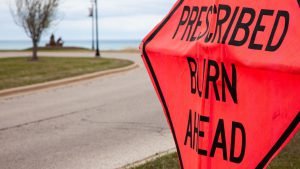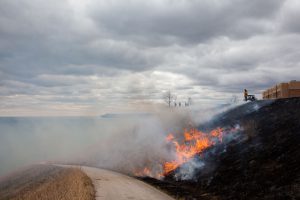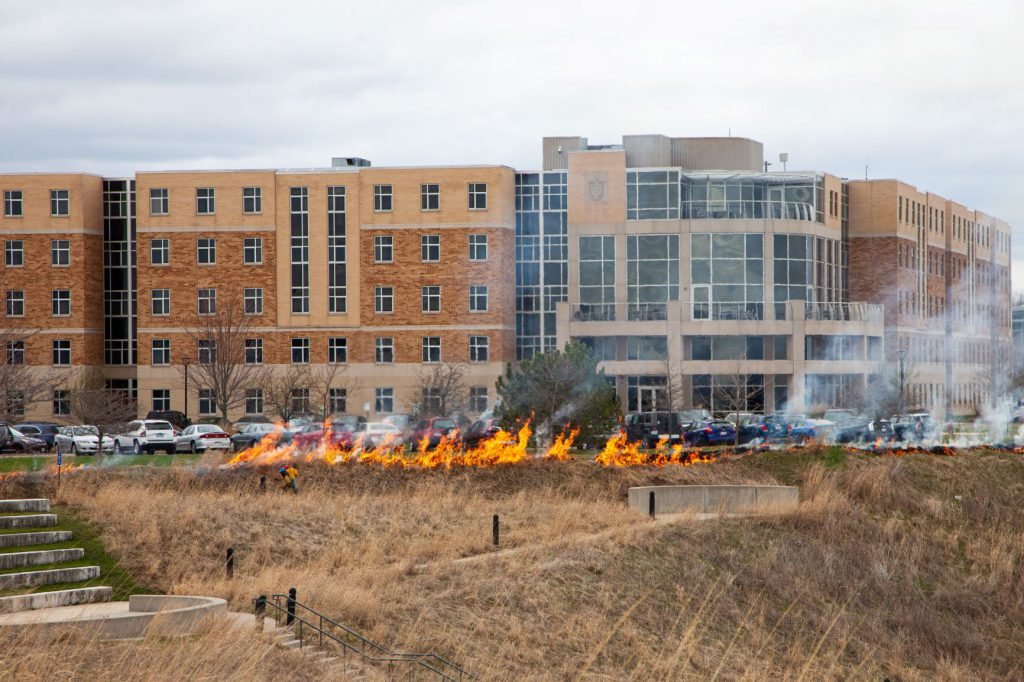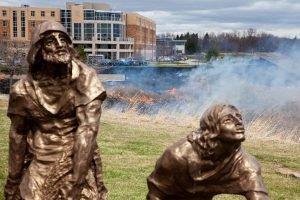
CUW's annual "bluff burn" clears the way for native plants to thrive, which helps keep our cherished shoreline healthy and beautiful—and also from sliding into Lake Michigan.
 Tuesday, April 13, 10:55 a.m: A campus-wide email hit my mailbox. There would be a “bluff burn” today, it said, starting at 11:00 a.m. That sounds like a good photo-op, I thought, but it starts in five minutes! So I jumped in the car and headed to campus (I was working at home that day) to see what there was to see.
Tuesday, April 13, 10:55 a.m: A campus-wide email hit my mailbox. There would be a “bluff burn” today, it said, starting at 11:00 a.m. That sounds like a good photo-op, I thought, but it starts in five minutes! So I jumped in the car and headed to campus (I was working at home that day) to see what there was to see.
Why such short notice? Turns out it’s all about the weather conditions, said Steve Hibbard, CUW’s director of buildings and grounds.
“Before a burn is done, we develop a plan, notify the fire department, and then set a target date,” Hibbard explained. “It’s usually in the spring, when things are wetter, and we would prefer the winds going west to east, so the smoke blows out over the lake instead of into Mequon. Tuesday looked like it might fit the criteria, but the decision wasn’t made to proceed until about an hour before the actual burn.”
By the time I rolled into campus, the flames were already lapping at the hillside, supervised closely by a crew from Eco-Resource Consulting (ERC). Because fire spreads much more quickly uphill, they started burning at the top of the bluff. This helps keep the flames from getting out of control. And though it may seem destructive, the fire is actually doing quite a lot of good.
“There are a number of reasons you would want to do a controlled burn,” Hibbard said. “Our main purpose at CUW is to get rid of the invasive species growing on the bluff. Invasive species are shallow-rooted and can take over an area rather quickly. The burn does not damage the native species which are deep rooted, and allows the native plants a window of time to re-establish on the bluff. The deep roots also help in the stability of the bluff.”
Fire is normally a natural process that destroys woody plants and helps grasses thrive. The ashes also make excellent natural fertilizer, which helps things spring quickly back to life. Just how God intended all along.
The catch is, natural fires are unpredictable, hard to control, and often destructive. Especially if they don’t happen frequently and excess combustible debris accumulates. In situations like the one at CUW, an artificial “prescribed burn” actually helps maintain the natural order of things. After the burn, the entire area will be over-seeded to encourage more growth of the good stuff.
“If you keep an eye on the bluff,” Hibbard said, “you will see how quickly things green back up.”
When you think about it, there’s a spiritual lesson in there. When we repent of the “invasive” sin in our lives, it clears the way for the Spirit of God to work more fully inside us (see 1 John 1:9). The soil of our souls becomes more fertile. And our lives become more stable, more beautiful, and more like what God intended for us all along.
RELATED: 11 of the Most Beautiful Places on CUW’s Campus
— This story is written by Mike Zimmerman, corporate communications manager for Concordia University Wisconsin. He may be reached at michael.zimmerman@cuw.edu or 262-243-4380.
If this story has inspired you, why not explore how you can help further Concordia's mission through giving.


